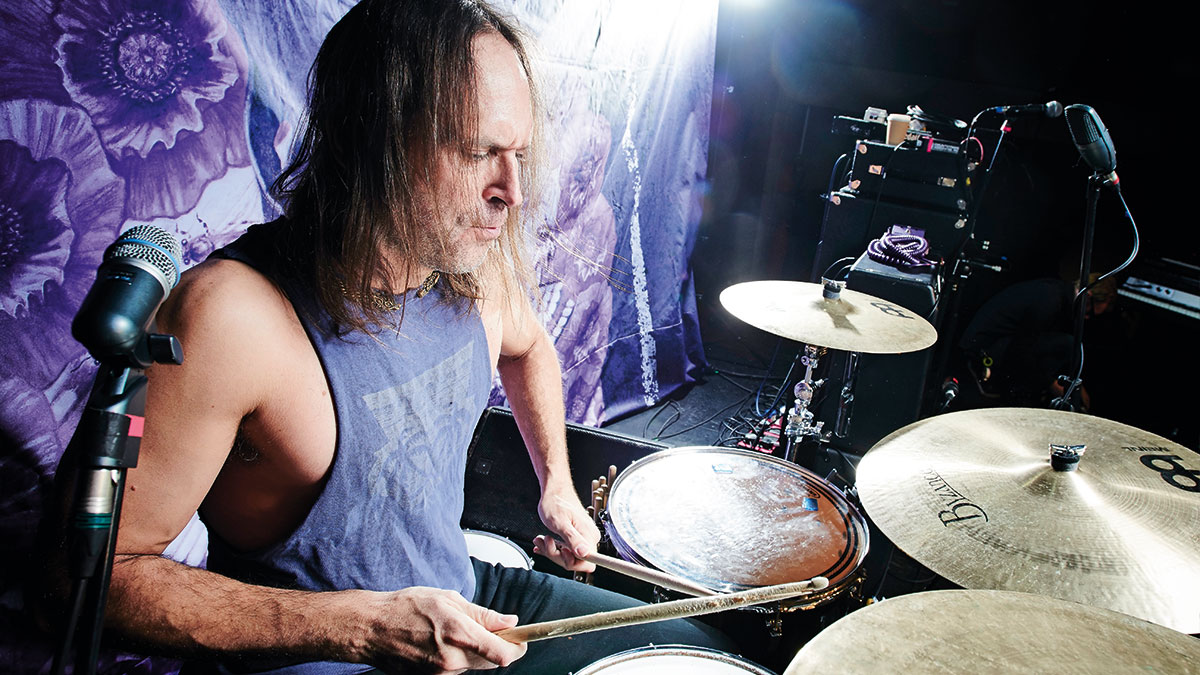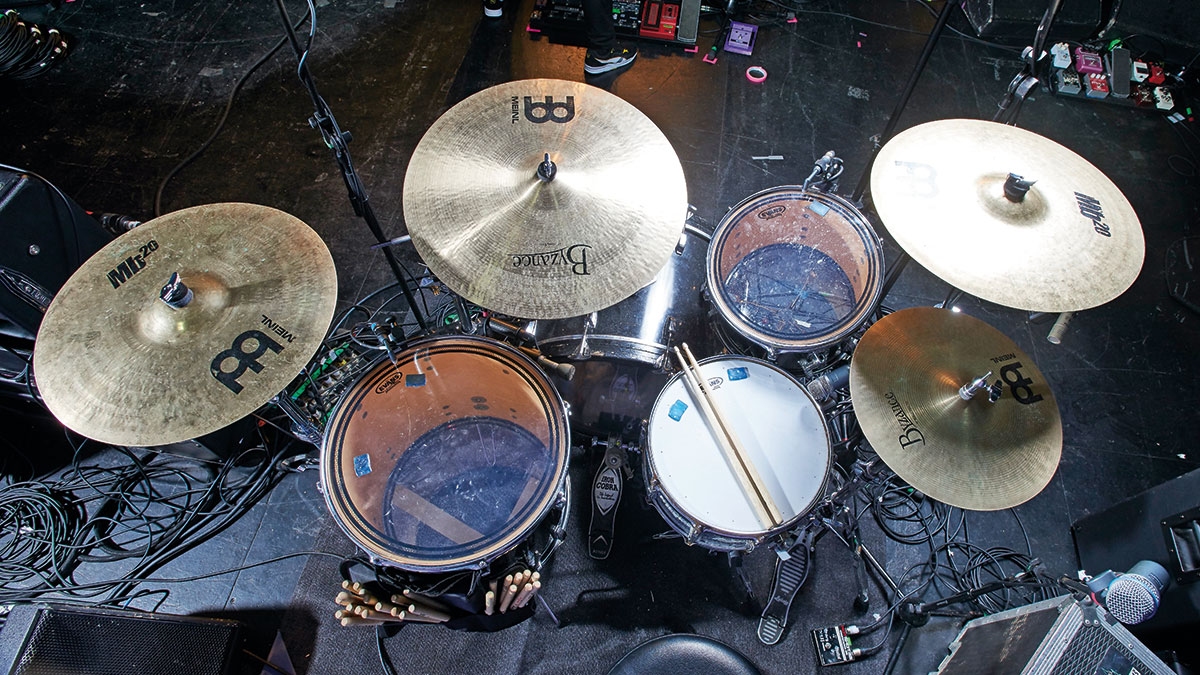Sebastian Thomson on the rebirth of Baroness
New drummer on pushing through tragedy to create the metal album of 2015

"For some people there is no other option except for music. I'm one of those people."
The crossing of paths between Georgia metallers Baroness and post-rock drumming journeyman Sebastian Thomson required an almightily traumatic experience to be set in motion.
Back in the summer of 2012 Baroness were touring the UK with original drummer Allen Blickle. Meanwhile, Thomson was taking a break from his long-term experimental-rock outfit Trans Am and was touring Europe with his electro side project. As Thomson decided to look for new opportunities to fill the gaps left by Trans Am’s inactivity, Baroness’s world changed.
On 15 August 2012, in poor weather conditions the Baroness tour bus plunged 30 feet from a viaduct in a terrifying crash. The accident left Blickle and bass player Matt Maggioni the most seriously injured, with both suffering fractured vertebrae. Neither would perform with Baroness again.
As remaining members John Baizley and Pete Adams regrouped they looked to who could fill the void left by their departing band mates. Thanks to a recommendation from Mastodon’s Brann Dailor, Sebastian got the call.
Two years later Baroness continued their unlikely revival to releasing the astonishing Purple, without doubt the band’s finest record to date, and an album that sees Sebastian fit right in from the getgo. To get the story behind this miraculous return we sat down with Sebastian as the band headed back into the UK and found out all about the rebirth of Baroness.
How did you get the call to join Baroness?
“Trans Am had become more part time a couple of years ago. My band mates had decided to start families and that kind of thing. Luckily, this opportunity came at the same time. Unfortunately, this opportunity came up because of the accident that Baroness had. Basically, the accident happened and I’m pretty sure Allen just didn’t want to tour any more.
"John started thinking about getting a new drummer and he didn’t want to do auditions, he didn’t want studio or session guys, he wanted somebody that had been in a band that he liked, somebody that had been on tour and had made records and someone that was a friend of a friend. I think it was Brann Dailor that suggested my name to the band. John had seen Trans Am before and he liked my drumming. He called me and we spoke on the phone for maybe two hours and he asked me to learn maybe eight of their songs. A week later I went down there and we played and it kind of sounded really good right from the start.”
You mentioned the accident then, what was the mood like in the camp when you came in following such a tough time?
“The mood I got from John and Pete was that I felt they were inpatient in a good way. Yellow & Green was getting a lot of good attention and it was early on in the tour that the accident happened and it totally delayed their lives. I’ve never gone through anything like that but apart from all of the physical and emotional issues it must have also been professionally very frustrating. They were excited to get back on the road and also to play with some new guys. They grew up with Allen so it was maybe fun for them to hear what the songs sounded like with a new member. I was excited and inpatient too, I wanted to prove to myself that I could do it.”
"I think it was Brann Dailor that suggested my name to the band. John had seen Trans Am before and he liked my drumming."
It shows the passion that John and Pete have to carry on touring after such a horrific experience
“For some people there is no other option except for music. I’m one of those people, which is a little bit scary. I’ve been fortunate that I have never had to work a day job. I’m still living like a college student. I don’t know what else I could or would want to do at this point and I think John and Pete are like that as well. This isn’t just what we do, this is what we are.”
Had the band already started writing Purple when you joined?
“I think there are two riffs, the main verse for The Iron Bell and the main riff from Desperation Burns that came from before Nick [Jost, bass] and I joined but everything else is new. We started pretty fresh.”
Did you quickly click in the studio?
“Playing the old songs came very easily, but starting to write together was a slower process. It’s a personal thing writing music. It’s a deep relationship. It took us a while to figure out how best to do it. At first all four of us would be in the rehearsal space writing and jamming. It was too many cooks in the kitchen. It was unfocused.”
How did you get past that?
“John is the main songwriter so we would start with me and John - this is rock music; you need drums and guitar, right? We would just work out rhythms and riffs. Then John would meet with Nick and work on chord progressions or meet with Pete and work on guitar stuff. Once it started getting fleshed out we would all get together. That was way more efficient. It was a pretty slow process but I was happy with that.
“It’s kind of the opposite of Trans Am, which is quite minimal musically and intentionally so. I’ll write a couple of bass lines with Trans Am, we’ll flesh it out and when you hear the song on the album it is maybe the fourth time we’ve ever played it. Baroness is the opposite, we were mastering the demos, it was to that level of detail. It was a fun change to go into the details. It took us a year which I guess maybe isn’t that long when you consider that half the band was new. We got into the details of what groove to use here and what harmony to use here. Recording was fantastic.”

Seb's Gear
Was there any gear that was key to getting the record’s drum sound?
“I like not a totally unfocused sound but I like some compressed room in there. As far as the kit, I always use the same snare, an old Ludwig, it was a Super Sensitive but then I changed the snare throw. That’s from 1980 or 1979 and it has been on all the Trans Am records. It has an amazing crack to it. It’s a 14”x7.5”.
“I'm also known for using rototoms instead of toms and I used those on Kerosene and Desperation Burns. I didn’t use any toms on those songs, it’s all rototoms. As drummers we can be very conservative, I mean look at how long the basic kit of hats, ride, snare, kick, toms has been around. It is really conservative. It’s 2016, let’s do something else maybe. I’m not a fan of having every bell and whistle, I like the idea of a concept. For a while with Trans Am I used rototoms instead of toms kind of like Terry Bozzio did with Missing Persons.”
“I have been talking about taking the rotos on tour."
What is it about rototoms that appeal to you?
“You can fit more rototoms into the space that toms take up so you can move around the kit quickly. Another advantage is that you can mic them from underneath and put the mic in the middle of the head. That makes them sound incredibly full. They sound insane miked up. The biggest roto I have is a 14” and it sounds like an 18” floor tom.”
You mentioned that you like a concept to your kit. What’s the next concept?
“I have been talking about taking the rotos on tour. I have not done that yet. I’m not the best at reaching around a massive kit, I like everything tight. It also goes against my concept. I mean, if I add the rotos in what next, am I going to add a splash in there? Baroness is a rock band so I don’t want to get too far away from a rock drum kit. But we’ll see, maybe I’ll take rotos on the next tour.”
Seb's Kit
Ludwig Maple Classic drum kit
24” bass drum
14” tom
18” floor tom
14”x7.5” Ludwig Super Sensitive snare
Meinl Byzance Cymbals
15” hi hats
18” crash x2
22” heavy ride
Evans heads

Rich is a teacher, one time Rhythm staff writer and experienced freelance journalist who has interviewed countless revered musicians, engineers, producers and stars for the our world-leading music making portfolio, including such titles as Rhythm, Total Guitar, Guitarist, Guitar World, and MusicRadar. His victims include such luminaries as Ice T, Mark Guilani and Jamie Oliver (the drumming one).
“Tonight is for Clem and it’s for friendship. An amazing man and a friend of the lads”: Sex Pistols dedicate Sydney show to Clem Burke
“Almost a lifetime ago, a few Burnage lads got together and created something special. Something that time can’t out date”: Original Oasis drummer Tony McCarroll pens a wistful message out to his old bandmates
“Tonight is for Clem and it’s for friendship. An amazing man and a friend of the lads”: Sex Pistols dedicate Sydney show to Clem Burke
“Almost a lifetime ago, a few Burnage lads got together and created something special. Something that time can’t out date”: Original Oasis drummer Tony McCarroll pens a wistful message out to his old bandmates









